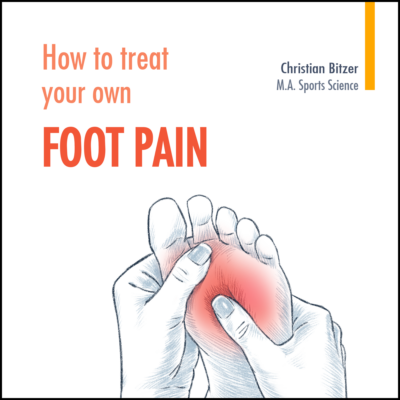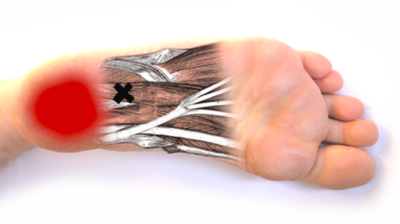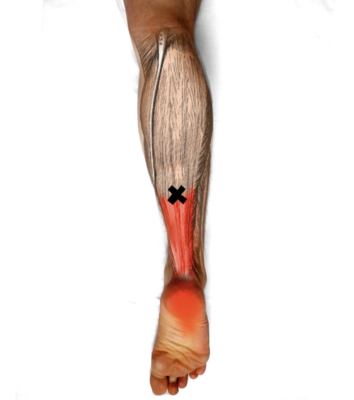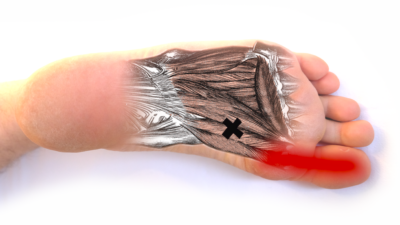Can massage help with polyneuropathy?
If you are in pain, you automatically tend to massage the painful areas. This may be useful in polyneuropathy, too. Unfortunately, massage can not heal damaged nerves. However, massage can often help reduce pain anyway. This is because massage can eliminate other causes of pain and therefor help reduce the pain even if you have polyneuropathy.
Pain in polyneuropathy does not always originate in the damaged nerves. Very often, pain from other causes adds to the pain caused by nerve damage, namely pain from overloaded muscles. This pain can be significantly improved by simple massage techniques.
You can find a complete guide to self-treatment of pain in polyneuropathy here: Pain in polyneuropathy
Nerve pain and muscle pain reinforce each other
In very many cases, pain from the muscles adds to the pain caused by the nerves that are damaged by polyneuropathy. This is called Myofascial Pain Syndrome and it is the most common cause of musculoskeletal pain of all.
It is caused by small cramps at specific points in the muscle fibers that cannot resolve on their own. These mini cramps disrupt the work of the affected muscle and nerves. They can cause an incredible amount of pain and can even lead to joint blockages.
Muscle pain is more common in polyneuropathy
When you suffer from polyneuropathy, it is very common to have these problems in the muscles. This is because the interaction between nerves and muscles no longer works as it does in healthy people. The way you move will change - mostly for the worse - and you might get bad posture. This creates additional stress on the muscules, that have already been weakened by the disease.
Muscle and nerve pain are virtually indistinguishable
As a result, more and more such cramps occur. This adds pain from the muscles to the pain that polyneuropathy already causes.
In this case, it is practically indistinguishable what one exactly causes the pain - the polyneuropathy or the muscle spasms. Also for doctors and therapists, there is no way to determine whether pain is caused by nerve damage, i.e. polyneuropathy, or by muscle spasms.
Muscle problems in polyneuropathy are usually overlooked
Unfortunately, this connection between different causes of pain is ignored in the vast majority of cases. Because once you have the diagnosis of "polyneuropathy," no one will check for other options.
However, the only way to find out if massage can help you is by actually massaging the muscles. Because, as I said, there is no clear reliable way to diagnose this. However, no serious side effects of the massage are to be expected. So I think, you should just try the massage and see if it gives you some relief.
Massage of the muscles can reduce the pain in polyneuropathy
If muscle spasms are treated, improvements in pain are often achieved. I have even had several patients whose pain disappeared completely after treatment of the muscles. So, in these cases, the cause of the pain was not polyneuropathy but muscle spasm. In many cases, the pain can be reduced to smaller areas. In some patients I observed that after treatment of the muscles only the toes hurt and not the whole foot.
Exercise for polyneuropathy
You can also help yourself with polyneuropathy with special exercises. You can find instructions on how to do this here:
Basically, the closer the pain is to the center of you body, the greater the chances of reducing pain with massage. For example, if you calves or heel hurt, the chances for pain reduction are greater than if the pain is in the notorious areas in the tips of the toes.
How do you apply this?
The target of massage in polyneuropathy are so-called myofascial trigger points, which I will simply call trigger points in this article. As the word suggests, trigger points are what triggers pain.
These points are basically the center of muscle cramps. They are nodules the size of a pea that are very painful and can also cause referred pain. That is, if such a trigger point is located in the calf muscles, it might cause pain in the foot. So a lot of the times, you have to look for the cause of pain in a completely different place than where the pain is perceived.
Massage despite great sensitivity to touch
This is a huge benefit in polyneuropathy. Because many people have such intense pain and are so sensitive to touch due to polyneuropathy that direct massage of the painful areas is not possible at all.
For example, in many of My patients, the toes are so painful that they can hardly be touched.
However, if you know that the cause of the pain in the toes (the trigger point) is often in the lower leg, this opens up a treatment option that is completely unproblematic for patients.
Find the right spots
Fortunately, these points are usually found in the same spots and also cause pain in predictable locations. Therefore, with a little experience, it is relatively easy to find the right spots to massage.
You can tell very quickly if you have found the right spot by pressing into the muscles. You will often find spots where the pressure causes pain. This is a sign that you have found a trigger point, because a relaxed muscles do not hurt when you press on them.
The right amount of pressure is crucial in massage for polyneuropathy
You now continue to search with your fingertips, trying to find the most painful spot. You then massage this spot slowly with firm pressure. You should feel some pain while you are doing this. You should press so hard that you feel a sensation that is a little bit painful, but still feels comfortable. So it should be a type of pain that still feels good. If you press harder on the muscle and cause strong pain, the muscle reacts with defensive tension and you cause a greater tension rather than relaxation.
If you suffer from polyneuropathy you should learn how to do this massage yourself.
In my own practice, I use osteopathic methods to treat the aching muscles. This is usually almost painless for the patient and the muscles respond very well. However, the trigger points and the pain often come back, because the polyneuropathy and thus the core of the problem remains. Therefore, it is important for patients to learn how to help themselves with the appropriate massage instead of relying on someone else.
How this massage works
For this type of massage, you should first try to spot the trigger point as accurately as possible. The trigger point is located at the point in the muscle that hurts the most when you press on it. Once you have found this spot, you move your fingers about one or two centimeters away from the muscle and then move them over the painful area until you reach an area that does not hurt again.
Only press into the muscle while moving your fingers in ONE direction, then move them back to the starting position WITHOUT pressure and start again.
The skin is moved along with your fingers. This means that the fingers do NOT glide over the skin, but always stick to the same spot on the skin. After all, this massage should not cause effects in the skin, but deep in the muscles. Therefore, it is not necessary to use massage oil....
Do not overdo it.
This procedure is repeated 10-20 times. Afterwards, the trigger point should be left alone for some time to prevent painful overstimulation. You should massage the same trigger point again only after at least one hour.
Following the massage, it is useful to do some light movement.
Stretching after the massage
Special but simple stretching exercises after the massage help with relaxation. Especially with stretching exercises, you yourself will feel best what is good for you and what is too much. You can feel this better than any therapist. That is why it is especially important to learn how to do the stretching yourself at home. In my book "How to treat your own Foot Pain" you will find a corresponding stretching exercise for each muscle.
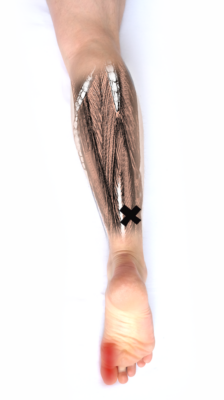
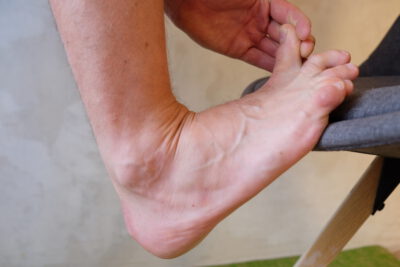
The cause of pain and the felt pain are not always in the same location
If the toes hurt, it is especially useful to massage the muscles that move the toes (flexor digitorum longus and flexor hallucis longus muscles). These are very often overlooked because they are located far away from the toes in the calf. However, the pain that that trigger points in these muscles cause is felt in the toes.
Massage of the soles of the feet can reduce pain
It is also often helpful for pain in the feet to massage the soles of the feet. Hard balls such as tennis balls, lacross balls or any other small hard ball can be used to do this. to do this, you simply place your foot on the ball and roll over the trigger point with some pressure and then return to the starting point without pressure and then repeat this 10-20 times. Again, it is very important not to apply too much pressure. Although a slight pain should be felt, the massage should be perceived as pleasant.
You can control the right amount of pressure yourself better than anyone else - you should feel some pain, but still be comfortable. Again: you yourself can tell better than anyone else how firm the massage should be and where exactly you shuold massage. Therefore, once you learn how this massage works, you are your own best therapist!
If you know the right places, massage for polyneuropathy is quite simple
As you can see, the tricky part in this form of massage is to find out where exactly the cause of pain - the trigger point - is. This is not easy, because there is a large number of muscles in the feet and lower legs. For example, each toe alone has two flexor and two extensor muscles (flexor digitorum brevis, flexor digitorum longus, extensor digitorum brevis, and extensor digitorum longus).
Get your massage guide
However, this complexity should not keep you from trying the massage. In my book "How to treat your own Foot Pain", I have listed all the pain areas of the feet with corresponding illustrations. So all you have to do is look at the pictures and you will know where exactly you should start to massage.
